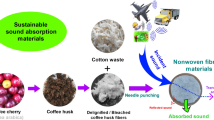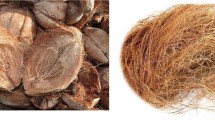Abstract
This work deals an experimental and theoretical research about the porous structure and the acoustic performance of cellulose acetate coming from the used cigarette filters. The porous structure was studied through the measurement and the prediction (using an inverse methodology) of some non-acoustic properties (bulk density, fiber size, porosity or flow resistivity and tortuosity). The sound absorption performance was evaluated by comparing experimental measurements using an impedance tube according to ISO 10534-2 with the best-fit approach obtained using some empirical models (Delany and Bazley, Garai-Pompoli, Komatsu and Miki). The accuracy of empirical models to obtain the flow resistivity was relatively high showing differences lower than 8% in the case of the Miki model or lower than 12% in the case of Delany & Bazley model. Regarding the absorption spectra, the errors found were lower than 9% for all the empirical models used in this work. These results showed that using relatively simple models such as empirical models were able to predict accurately the acoustic behaviour of the cellulose acetate. Finally, the sound absorption spectra obtained for cellulose acetate were compared with those obtained for fibrous materials currently used in building sector, suggesting that this fibrous waste could act as a possible substitute to traditional ones, due to the similar relatively high NRC values obtained for both type of fibrous absorber (NRC = 0.65).








Similar content being viewed by others
References
Lim ZY, Putra A, Nor MJM, Yaakob MY. Sound absorption performance of natural kenaf fibres. Appl Acoust. 2018;130:107–14. https://doi.org/10.1016/j.apacoust.2017.09.012.
Soltani P, Taban E, Faridan M, Samaei SE, Amininasab S. Experimental and computational investigation of sound absorption performance of sustainable porous material: Yucca Gloriosa fiber. Appl Acoust. 2020;157:106999. https://doi.org/10.1016/j.apacoust.2019.106999.
Taban E, Khavanin A, Ohadi A, Putra A, Jafari AJ, Faridan M, et al. Study on the acoustic characteristics of natural date palm fibres: experimental and theoretical approaches. Build Environ. 2019;161:106274. https://doi.org/10.1016/j.buildenv.2019.106274.
Raj M, Fatima S, Tandon N. An experimental and theoretical study on environment-friendly sound absorber sourced from nettle fibers. J Build Eng. 2020;31:101395. https://doi.org/10.1016/j.jobe.2020.101395.
Maderuelo-Sanz R, Nadal-Gisbert AV, Crespo-Amorós JE, Parres-García F. A novel sound absorber with recycled fibers coming from end of life tires (ELTs). Appl Acoust. 2012;73:402–8. https://doi.org/10.1016/j.apacoust.2011.12.001.
Khan A, Mohamed M, Al Halo N, Benkreira H. Acoustical properties of novel sound absorbers made from recycled granulates. Appl Acoust. 2017;127:80–8. https://doi.org/10.1016/j.apacoust.2017.05.035.
Rubino C, Aracil MB, Liuzzi S, Stefanizzi P, Martellotta F. Wool waste used as sustainable nonwoven for building applications. J Clean Prod. 2021;278:123905. https://doi.org/10.1016/j.jclepro.2020.123905.
Maderuelo-Sanz R, Barrigón Morillas JM, Gómez Escobar V. The performance of resilient layers made from cork granulates mixed with resins for impact noise reduction. Eur J Wood Wood Prod. 2014;72:833–5. https://doi.org/10.1007/s00107-014-0845-1.
Yun BY, Cho HM, Kim YU, Lee SC, Berardi U, Kim S. Circular reutilization of coffee waste for sound absorbing panels: a perspective on material recycling. Environ Res. 2020;184:109281. https://doi.org/10.1016/j.envres.2020.109281.
Gadea Borrell JM, Juliá Sanchis E, Segura Alcaraz J, Montava Belda I. Sustainable sound absorbers from fruit stones waste. Appl Acoust. 2020;161:107164. https://doi.org/10.1016/j.apacoust.2019.107174.
Malawade UA, Jadhav MG. Investigation of the acoustic performance of bagasse. J Mater. 2020;9:882–9. https://doi.org/10.1016/j.jmrt.2019.11.028.
The Tobacco Atlas. Consumption. https://tobaccoatlas.org/topic/consumption/. 2018 (Accessed 13 October 2019).
Kurmus H, Mohajerani A. The toxicity and valorization options of cigarette butts. Waste Manag. 2020;104:104–18. https://doi.org/10.1016/j.wasman.2020.01.011.
Torkashvand J, Farzadkia M, Sobhi HR, Esrafili A. Littered cigarette butt as a well-known hazardous waste: a comprehensive systematic review. J Hazard Mater. 2020;383:121242. https://doi.org/10.1016/j.jhazmat.2019.121242.
Mohajerani A, Kadir AA, Larobina L. A practical proposal for solving the world’s cigarette butt problem: recycling in fired clay bricks. Waste Manag. 2016;52:228–44. https://doi.org/10.1016/j.wasman.2016.03.012.
Mohajerani A, Tanriverdi Y, Nguyen BT, Wong KK, Dissanayake HN, Johnson L, et al. Physico-mechanical properties of asphalt concrete incorporated with encapsulated cigarette butts. Constr Build Mater. 2017;153:69–80. https://doi.org/10.1016/j.conbuildmat.2017.07.091.
Teixeira MBH, Duarte MAB, Garcez LR, Rubim JC, Gatti TH, Suarez PAZ. Process development for cigarette butts recycling into cellulose pulp. Waste Manag. 2017;60:140–50. https://doi.org/10.1016/j.wasman.2016.10.013.
Zhao J, Zhang N, Qu C, Wu X, Zhang J, Zhang X. Cigarette butts and their application in corrosion inhibition for N80 steel at 90° C in a hydrochloric acid solution. Ind Eng Chem Res. 2010;49(8):3986–91. https://doi.org/10.1021/ie100168s.
Ghosh TK, Sadhukhanc S, Ranad D, Sarkarc G, Dase C, Chattopadhyaye S, et al. Treatment of recycled cigarette butts (man-made pollutants) to prepare electrically conducting material. J Indian Chem Soc. 2017;94:863–70.
Sabzali A, Nikaeen M, Bina B. Evaluation of cigarette filters rods as a biofilm carrier in integrated fixed film activated sludge process. World Acad Sci Eng Technol. 2011;5:82–7. https://doi.org/10.5281/zenodo.1069943.
Marinello S, Lolli F, Gamberini R, Rimini B. A second life for cigarette butts? A review of recycling solutions. J Hazard Mater. 2020;384:121245. https://doi.org/10.1016/j.jhazmat.2019.121245.
Delany ME, Bazley EN. Acoustical properties of fibrous absorbent materials. Appl.Acoust. 1970;3(2):105–16. https://doi.org/10.1016/0003-682X(70)90031-9.
Garai M, Pompoli F. A simple empirical model of polyester fibre materials for acoustical applications. Appl Acoust. 2005;66(12):1383–98. https://doi.org/10.1016/j.apacoust.2005.04.008.
Miki Y. Acoustical properties of porous materials-generalizations of empirical models. J Acoust Soc Jpn. 1990;11:25–8. https://doi.org/10.1250/ast.11.25.
Mechel FP. Design charts for sound absorber layers. J Acoust Soc Am. 1988;83(3):1002–13. https://doi.org/10.1121/1.396045.
Komatsu T. Improvement of the Delany-Bazley and Miki models for fibrous sound-absorbing materials. Acoust Sci Technol. 2008;29(2):121–9. https://doi.org/10.1250/ast.29.121.
Johnson DL, Koplik J, Dashen R. Theory of dynamic permeability and tortuosity in fluid-saturated porous media. J Fluid Mech. 1987;176:379–402. https://doi.org/10.1017/S0022112087000727.
Champoux Y, Allard JF. Dynamic tortuosity and bulk modulus in air saturated porous media. J Appl Phys. 1991;70(4):1975–9. https://doi.org/10.1063/1.349482.
Pride SR, Gangi AF, Morgan FD. Deriving the equations of motion for porous isotropic media. J Acoust Soc Am. 1992;92:3278–90. https://doi.org/10.1121/1.404178.
Pride SR, Morgan FD, Gangi AF. Drag forces of porous-medium acoustics. Phys Rev B. 1993;47:4964–78. https://doi.org/10.1103/PhysRevB.47.4964.
Lafarge D, Lemarinier P, Allard JF, Tarnow V. Dynamic compressibility of air in porous structures at audible frequencies. J Acoust Soc Am. 1997;102:1995–2006. https://doi.org/10.1121/1.419690.
Allard JF, Atalla N. Propagation of sound in porous media: modelling sound absorbing materials. 2nd ed: Wiley; 2009. https://doi.org/10.1007/978-94-011-1866-8.
Gómez Escobar V, Maderuelo Sanz R. Acoustical performance of samples prepared with cigarette butts. Appl Acoust. 2017;125:166–72. https://doi.org/10.1016/j.apacoust.2017.05.001.
Maderuelo-Sanz R, Gómez Escobar V, Meneses Rodríguez JM. Potential use of cigarette filters as sound porous absorber. Appl Acoust. 2018;129:86–91. https://doi.org/10.1016/j.apacoust.2017.07.011.
Gómez Escobar V, Rey Gozalo G, Pérez CJ. Variability and performance study of the sound absorption of used cigarette butts. Materials. 2019;12(16):2584. https://doi.org/10.3390/ma12162584.
Koutela N, Fernández E, Saru ML, Psillakis E. A comprehensive study on the leaching of metals from heated tobacco sticks and cigarettes in water and natural water. Sci Total Environ. 2020;714:136700. https://doi.org/10.1016/j.scitotenv.2020.136700.
Mwaikambo LY, Ansell MP. Chemical modification of hemp, sisal, jute, and kapok fibers by alkalization. J Appl Polym Sci. 2002;84(12):2222–34. https://doi.org/10.1002/app.10460.
Lee Y, Joo C. Sound absorption properties of recycled polyester fibrous assembly absorbers. Autex Res J. 2003;3:78–84. http://www.autexrj.com/cms/zalaczone_pliki/5-03-2.pdf. Accessed 30 June 2020.
Maderuelo-Sanz R, Martín-Castizo M, Vilchez-Gómez R. The performance of resilient layers made from recycled rubber fluff for impact noise reduction. Appl Acoust. 2011;72:823–8. https://doi.org/10.1016/j.apacoust.2011.05.004.
ASTM, ASTM D-3776. Standard test methods for mass per unit area (Weight) of fabric. 2007 Annual book of ASTM standards. 2007. www.astm.org. Accessed 12 May 2020.
Yang Y, Chen Z, Chen Z, Fu R, Li Y. Sound insulation properties of sandwich structures on glass fiber felts. Fiber Polym. 2015;16:1568–77. https://doi.org/10.1007/s12221-015-5200-6.
Kucuk M, Korkmaz Y. Sound absorption properties of bilayered nonwoven composites. Fiber Polym. 2016;16:941–8. https://doi.org/10.1007/s12221-015-0941-9.
Maderuelo-Sanz R, Nadal-Gisbert AV, Crespo-Amorós JE, Barrigón Morillas JM, Parrés-García F, Juliá Sanchís E. Influence of the microstructure in the acoustical performance of consolidated lightweight granular materials. Acoust Aust. 2016;44:149–57. https://doi.org/10.1007/s40857-016-0048-5.
Bies DA, Hansen CH. Flow resistance information for acoustical design. Appl Acoust. 1980;13(5):357–91. https://doi.org/10.1016/0003-682X(80)90002-X.
Ingard KU, Dear TA. Measurement of acoustic flow resistance. J Sound Vib. 1985;103(4):567–72. https://doi.org/10.1016/S0022-460X(85)80024-9.
Johnson DL, Plona TJ, Scala C, Pasierb F, Kojima H. Tortuosity and acoustic slow waves. Phys Rev Lett. 1982;49:1840–4. https://doi.org/10.1103/PhysRevLett.49.1840.
Attenborough K. Models for the acoustical characteristics of air filled granular materials. Acta Acust. 1993;64:27–30.
Attenborough K. Acoustical characteristics of rigid fibrous absorbents and granular materials. J Acoust Soc Am. 1983;73:785–99. https://doi.org/10.1121/1.389045.
ISO 10534-2. Acoustics determination of sound absorption coefficient and impedance in impedance tubes. Part 2: Transfer function method. International Organization for Standardization, Geneva 1998.
ASTM, ASTM C423. Standard test method for sound absorption and sound absorption coefficients by the reverberation room method. 2017 Annual book of ASTM standards. 2017. www.astm.org. Accessed 17 Oct 2020.
Pelegrinis MT, Horoshenkov KV, Burnett A. An application of Kozeny–Carman flow resistivity model to predict the acoustical properties of polyester fibre. Appl.Acoust. 2016;101:1–4. https://doi.org/10.1016/j.apacoust.2015.07.019.
Berardi U, Iannace G. Acoustic characterization of natural fibers for sound absorption applications. Build Environ. 2015;94:840–52. https://doi.org/10.1016/j.buildenv.2015.05.029.
Hurrell AI, Horoshenkov KV, Pelegrinis MT. The accuracy of some models for the airflow resistivity of nonwoven materials. Appl Acoust. 2018;130:230–7. https://doi.org/10.1016/j.apacoust.2017.09.024.
Acknowledgements
The author is grateful to INTROMAC and Regional Office of Economics, Science and Digital Agenda of the Government of Extremadura.
Funding
This research did not receive any specific grant from funding agencies in the public, commercial, or not-for-profit sectors.
Author information
Authors and Affiliations
Corresponding author
Ethics declarations
Conflict of interest
The authors declare that there are no conflicts of interest.
Additional information
Publisher’s note
Springer Nature remains neutral with regard to jurisdictional claims in published maps and institutional affiliations.
Rights and permissions
About this article
Cite this article
Maderuelo-Sanz, R. Characterizing and modelling the sound absorption of the cellulose acetate fibers coming from cigarette butts. J Environ Health Sci Engineer 19, 1075–1086 (2021). https://doi.org/10.1007/s40201-021-00675-0
Received:
Accepted:
Published:
Issue Date:
DOI: https://doi.org/10.1007/s40201-021-00675-0




